Sliced pepperoncini and banana peppers differ in shape, color, skin texture, taste, and heat levels. Pepperoncini is slightly spicier and has more wrinkled skin than banana peppers, which are milder and smoother.
What Are Banana Peppers?
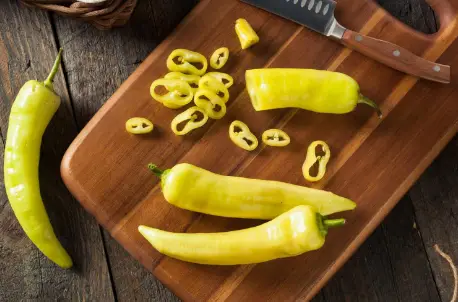
Banana peppers are a variety of sweet pepper named for their curved, elongated shape, which resembles a banana. They are typically yellow but can also be found in red and orange hues as they ripen. Banana peppers have a mild, sweet flavor with a slight tang and measure 0-500 Scoville units, making them a gentle addition to various dishes.
What Are Pepperoncini?
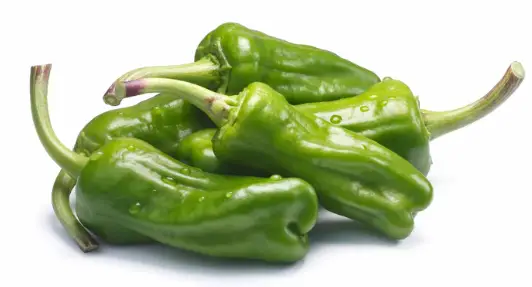
Pepperoncini, also known as Tuscan or golden Greek peppers, is a chili pepper commonly used in Mediterranean cuisine. They are usually greenish-yellow in color and have slightly wrinkled skin. Pepperoncini are known for their tangy, slightly bitter flavor and mild heat, measuring between 100-500 Scoville units. They are often pickled and used as a garnish, condiment, or ingredient in various dishes.
Differences Between Sliced Banana Peppers And Sliced Pepperoncini
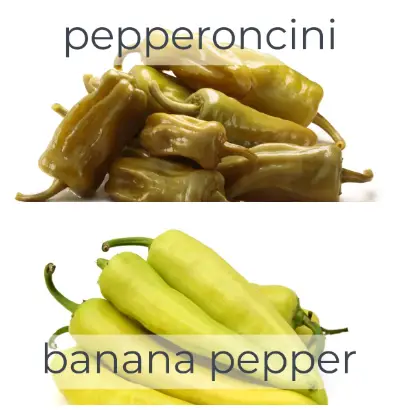
- Shape: Banana peppers are longer and more curved, resembling a banana, while pepperoncini are shorter and bulbous.
- Color: Banana peppers are bright yellow, while pepperoncini have a greenish-yellow hue.
- Skin Texture: Banana peppers have smooth skin, while pepperoncini have a slightly wrinkled appearance.
- Taste: Banana peppers have a mild, sweet flavor, while pepperoncini are slightly tangy with a hint of bitterness.
- Heat: Banana peppers measure 0-500 Scoville units, making them quite mild, while pepperoncini have a bit more kick with 100-500 Scoville units.
Similarities Between Sliced Banana Peppers And Sliced Pepperoncini
- Growing Zones: Both peppers thrive in similar growing zones and environments.
- Nutritional Content: They both have similar nutritional profiles, containing vitamins A, C, and K, as well as antioxidants.
- Cuisine: Both peppers are commonly used in Mediterranean and American dishes.
The Ultimate Pepper Duel: Health, Taste, And Versatility
Health Benefits
Both sliced banana peppers and sliced pepperoncini offer similar health benefits due to their similar nutritional content. However, the slight difference in heat levels might contribute to minor differences in anti-inflammatory properties and metabolism-boosting effects.
Taste Test
Taste is subjective, and the preferred pepper will depend on individual preferences. Banana peppers are ideal for those who enjoy a milder, sweeter flavor, while pepperoncini are perfect for those who like a tangy kick with bitterness.
Versatility In The Kitchen
Both peppers are quite versatile, but the mild flavor of banana peppers makes them more adaptable for various dishes. They can be used in savory and sweet recipes, while pepperoncini are best suited for savory dishes with a tangy twist.
The Great Pepper Swap: Substitution Possibilities
While they are not exact substitutes, sliced banana peppers, and sliced pepperoncini can be used interchangeably in many recipes. However, remember the differences in heat and flavor profiles when making the swap.
Basic Cooking Techniques And Tips For Slicing Banana Peppers:

Follow these simple steps to slice banana peppers with ease:
Step 1: Clean the banana pepper: Wash it thoroughly under running water and pat it dry with a clean towel or paper towel.
Step 2: Cut the pepper in half: Place it horizontally on a cutting board and cut it in half lengthwise.
Step 3: Remove the ribs (optional): If you prefer to remove them, gently run your knife along the rib to separate it from the pepper.
Step 4: Slice the banana pepper: Hold each half of the pepper with the flat side down on the cutting board. Make long, even cuts up and down the pepper to create slices of your desired thickness.
How To Slice Banana Peppers For Salads?
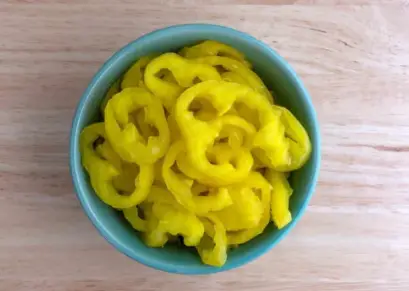
To slice banana peppers for salads, follow these easy steps:
Step 1: Prepare the banana pepper: Start by cutting off the top of the banana pepper and removing the seeds. You can cut the pepper in half, but keeping it whole allows for attractive rings in your salad.
Step 2: Place the pepper on the cutting board: Position it on it so it’s stable and comfortable to cut. The pepper will naturally roll to its most stable position.
Step 3: Slice the banana pepper: Using a sharp knife, make even slices about 1/8-inch thick, cutting through the pepper. Try to keep the slices uniform to create visually appealing rings.
Step 4: Continue slicing: Keep slicing the pepper, maintaining consistent thickness throughout. Don’t worry if some slices are slightly larger or smaller than others, as this adds a touch of rustic charm to your salad.
Step 4: Rinse and remove any remaining seeds (optional): If you notice any seeds left in the sliced pepper rings, you can rinse them or leave them in your salad.
How To Slice Pepperoncini?
Slicing pepperoncini is a straightforward process that can add flavor and texture to many dishes. Pepperoncini is a mild chili pepper commonly used in Italian cuisine. They can be found in fresh and pickled forms, with the latter being more commonly used for slicing.
To slice pickled pepperoncini, follow these simple steps:
Step 1: Remove the stem: Use a sharp knife to cut off the stem end of each pepperoncino and discard it.
Step 2: Squeeze out the seeds: Hold each pepperoncino over a bowl or sink and gently squeeze to remove the seeds. You can use a small spoon or your fingers to help with this process. Discard the seeds.
Step 3: Slice the pepperoncini: Once you have removed the seeds, slice the pepperoncini into thin slices, about 1/2 inch thick. You can use a sharp knife or a mandoline slicer for this.
Step 4: Drain if needed: If the pepperoncini slices are extra juicy, you might need to drain them in a colander for a few minutes before using them in your recipe.
FAQs
Can I use sliced banana peppers in place of sliced pepperoncini?
Yes, but be aware of the differences in taste and heat levels when substituting.
Which pepper is spicier, banana pepper or pepperoncini?
Even though the difference is relatively minor, Pepperoncini are generally spicier than banana peppers.
Are there any dishes specifically calling for one type of pepper over the other?
Some recipes may specifically call for one type of pepper, but they can be used interchangeably in many cases.
Can I grow both types of peppers in my home garden?
Yes, both peppers can be grown in similar growing zones and environments.
Key Takeaways:
-
- Banana peppers and pepperoncini differ in shape, color, skin texture, taste, and heat levels.
- Both peppers have similar nutritional content and are used in the Mediterranean and
American cuisine.
- When considering health benefits, taste, and versatility, the choice between banana peppers and pepperoncini depends on individual preferences.
- While they are not exact substitutes, sliced banana peppers and sliced pepperoncini can be used interchangeably in many recipes.
table comparing
| Basis of Difference | Banana Peppers | Pepperoncini |
|---|---|---|
| Origin | South America | Italy and Greece |
| Variety | Two varieties: hot and sweet | Two varieties: Italian and Greek |
| Scoville Heat Units | 0-500 SHU | 100-500 SHU |
| Color | Ranging from yellow, green, orange to red | Ranging from yellow-green to red |
| Texture | Smooth, thick skin | Slightly wrinkled, thin skin |
| Shape | Long, curved, pointed ends | Crimped, folded, rounded ends |
| Taste | Sweeter | Juicier and more bitter |
| Plant | Up to 24 inches | Up to 30 inches |
| Where it grows | Every USDA zone s | Between 8 and 10 USDA zones |
| Nutritional Benefits | More calories than pepperoncini. Contain magnesium. | Fewer calories than banana peppers. Contains minerals. |
| Serving options | Best pickled and chopped to serve with sandwich and pizza | Best stuffed with cheese, meat, and vegetables |
| Pros | Mild heat, versatile, colorful, good for stuffing | Mild heat, good for pickling, adds depth of flavor to dishes |
| Cons | May lack flavor and heat for some dishes, thicker skin may be difficult to cook with | May be too bitter for some tastes, thin skin may be difficult to stuff or cook with |
Conclusion
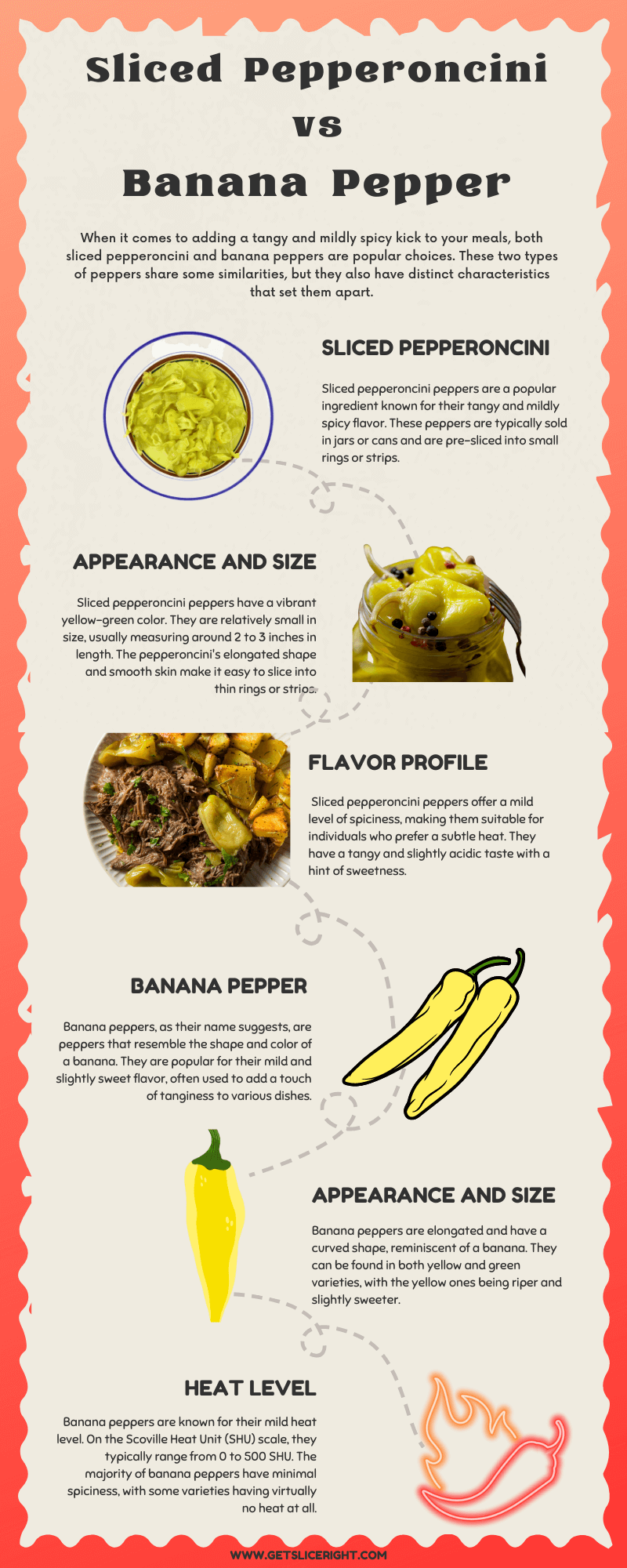
The choice between sliced banana peppers and sliced pepperoncini comes down to personal preference regarding taste, heat, and versatility. Both peppers offer a range of culinary options and can be used in various dishes to add a touch of spice and flavor. So experiment with both types of peppers to find your favorite and spice up your next meal.

Mario Batali is a renowned author, food enthusiast, and passionate chef who has dedicated his life to exploring the world of culinary arts. With a love for sharing his knowledge and experiences, Mario has become a prominent figure in the food blogging community, inspiring countless readers with his creativity and expertise.
In addition to his culinary prowess, Mario Batali is also a talented writer with a flair for engaging storytelling. He launched his own food blog to share his recipes, cooking tips, and personal experiences in the kitchen. Over time, Mario’s blog gained a loyal following of food enthusiasts who appreciate his unique approach to cooking and his dedication to using only the finest ingredients.
Mario Batali’s passion for food and his commitment to sharing his knowledge with others have made him a true inspiration in the world of culinary arts. Through his blog, cookbooks, and public appearances, Mario continues to spread his love of food and the joy of cooking with his ever-growing fanbase.






